Order Artiodactyla Higher classification Oxen | Phylum Chordata Genus Bos Mass 680 – 910 kg (Adult) Rank Species | |
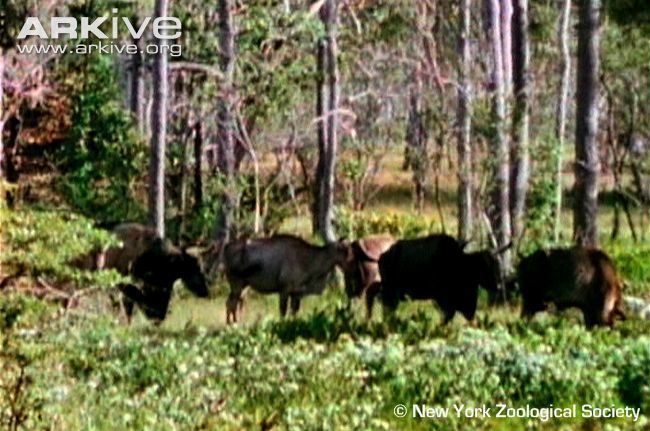 | ||
Height 1.7 – 1.9 m (Adult, At Shoulder) Length 2.1 – 2.3 m (Adult, Without Tail) Similar Eld's deer, Banteng, Gaur, Oxen, Schomburgk's deer | ||
Kouprey bos sauveli cambodia
A kouprey (Bos sauveli, from Khmer: គោព្រៃ, [koː prɨj], "wild ox"; also known as kouproh, "grey ox"), is a wild, forest-dwelling bovine species found mainly in northern Cambodia and believed to exist in southern Laos, western Vietnam, and eastern Thailand. A young male was sent to the Vincennes Zoo in 1937 where it was described by the French zoologist Achille Urbain and was declared the holotype. The kouprey has a tall, narrow body, long legs, a humped back and long horns.
Contents
- Kouprey bos sauveli cambodia
- Description
- Habitat and distribution
- Diet
- Status
- Ongoing conservation efforts
- Relation to other species
- References
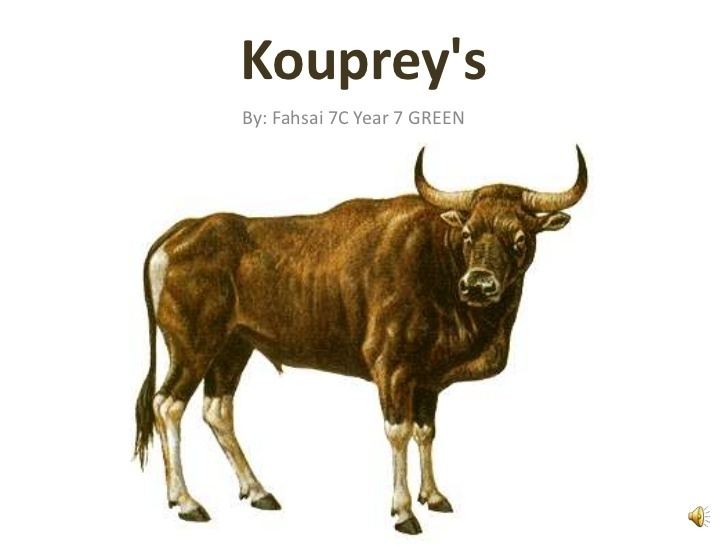
Kouprey form small herds led by a female, and graze on grasses, feeding in the forest during the day and in the open at night. They are affected by degradation of their habitat and are hunted for their meat, horns and skull. There are not thought to be many kouprey in existence, and the last confirmed sighting was in 1988. Since then surveys have been done to try to locate the species, but all have failed. The International Union for Conservation of Nature has rated the species as "critically endangered", but it may already be extinct.
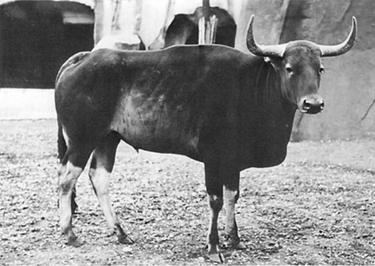
Description
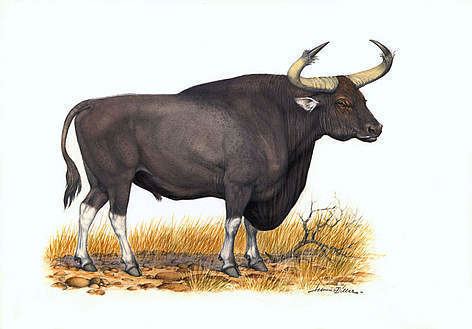
The kouprey is believed to be a close relative to the aurochs and the gaur. A very large ungulate, the kouprey can approach similar sizes to the wild Asian water buffalo. These bovids measure 2.1 to 2.3 m (6.9 to 7.5 ft) along the head and body, not counting a 1 m (3.3 ft) tail, and stand 1.7–1.9 m (5.6–6.2 ft) high at the shoulder. Their weight is reportedly from 680 to 910 kg (1,500 to 2,010 lb). Unverified reports of a body mass up to 1,700 kg (3,700 lb) from Vietnam are considered dubious, since they far exceed other recorded weights for the species.
Kouprey have tall, narrow, bodies, long legs and humped backs. They can be grey, dark brown or black. The horns of the female are lyre-shaped with antelope-like upward spirals. The horns of the male are wide and arch forward and upward; they begin to fray at the tips at about three years of age. Both sexes have notched nostrils and long tails.
Habitat and distribution
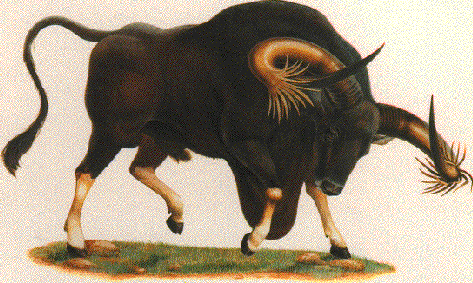
Historical distribution of this species included Cambodia, southern Laos, southeast Thailand, and western Vietnam. They are thought to be extinct in all areas outside of Cambodia. It likely exists in Lomphat Wildlife Sanctuary, Phnom Prich Wildlife Sanctuary, Mondulkiri Protected Forest, and/or Seima Biodiversity Conservation Area if still extant.
Kouprey live in low, partially forested hills, where they eat mainly grasses. Their preferred habitat is open forest and savannas often near thick monsoon forests. They are diurnal, eating in the open at night and under the forest cover during the day. They usually travel up to 15 km in a night.
They live in herds of up to 20 and are usually led by a single female. These herds generally consist of cows and calves, but have bulls during the dry season. Older males form bachelor herds. Many herds are known to break up and rejoin as they travel and have been found to be mixed in with herds of banteng or wild buffalo.
Diet
Kouprey graze on grasses, including bamboo, ploong, and koom. They also spend a lot of time around salt licks and water holes.
Status
There are estimated to be fewer than 250 kouprey left in the world. There is some speculation on whether or not they are already extinct. These low numbers are attributed to uncontrolled hunting by locals and soldiers for meat, horns and skulls for use in traditional Chinese medicine, in conjunction with diseases introduced from cattle and loss of habitat due to agriculture and logging activity.
Ongoing conservation efforts
Kouprey are legally protected in all range states and may be present in some protected areas. Prince Sihanouk designated it as the national animal of Cambodia in the 1960s, partly due to its mystique. Large mammal surveys continue to take place in Cambodia, hoping to rediscover living kouprey.
Surveys have been taking place in the kouprey's historical range as recently as 2011. These surveys were done to determine the regions in their range with the highest probability of the kouprey's persistence. This is based on the habitat type and survey effort to date.
In 1988 an International Workshop on Kouprey Conservation was held in the University of Hanoi. This workshop worked towards the responsible government agencies and interested donors to agree upon a workable and realistic action plan to save the kouprey.
However, no kouprey have been sighted since 1988. During the last decade, several searches for the animal have proven fruitless.
The 2008 IUCN report lists the kouprey as critically endangered (possibly extinct).
There is no captive population. The only individual in a western zoo was sent to the Vincennes Zoo at Paris in 1937; that was the individual designated as the holotype by Urbain. It died early in World War II.
Relation to other species
Research published by Northwestern University in London's Journal of Zoology indicated a comparison of mitochondrial sequences showed the kouprey might be a hybrid between a zebu and a banteng. However, the authors of this study rescinded their conclusion. Because a fossilized skull was found dating from the late Pleistocene or early Holocene epoch, they concluded the kouprey is not a hybrid. More recent genetic analysis has supported this position.
